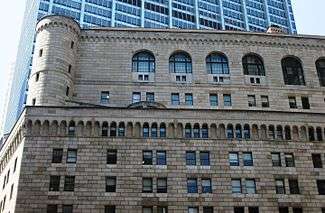Federal Reserve Bank of New York Building
Coordinates: 40°42′32″N 74°00′32″W / 40.708767°N 74.008756°W
|
Federal Reserve Bank of New York Building (33 Liberty Street) | |
|
(2015) | |
| Location |
33 Liberty Street Manhattan, New York City |
|---|---|
| Built | 1919-24, 1935 (eastern extension) |
| Architect | York and Sawyer |
| Architectural style | Florentine Renaissance |
| NRHP Reference # | 80002688 |
| Significant dates | |
| Added to NRHP | May 6, 1980 |
| Designated NYCL | December 21, 1965 |
The Federal Reserve Bank of New York Building at 33 Liberty Street, which occupies the full block between Liberty, William and Nassau Streets and Maiden Lane in the Financial District of Manhattan, New York City, is the headquarters of the Federal Reserve Bank of New York. It is where the monetary policy of the United States is executed by trading dollars and United States Treasury securities.[1]
The building also hosts a vault containing the world's largest depository of gold, stored on behalf of numerous government institutions from around the world.[2] Total holdings in 2015 amounted to approximately 6,350 tons of gold. Relatively little of this gold belongs to the United States Government; as of August 2016, the building's vault holds 13,400,000 troy ounces (460 short tons) of gold bullion and $3 million (book value) in gold coins for the United States, a little more than 5% of the United States' total gold reserve.[3]
The building was designated a landmark by the New York City Landmarks Preservation Commission in 1965,[4] and was added to the National Register of Historic Places in 1980.
Building and architecture

The visual impact of the neo-Renaissance structure derives from its monumental size, fortress-like appearance, fine proportions and the overall quality of construction. It set the precedent for many later banks which were greatly influenced by its design.[5]
Built from 1919 through 1924, with an extension to the east built in 1935, all designed by York and Sawyer with decorative ironwork by Samuel Yellin of Philadelphia,[6][7] this massive building occupies an entire city block, reaching fourteen stories tall with five additional floors underground.[5] The building tapers to become very narrow at its east end, following the footprint of the block it stands on.[5]
The stone exterior of the building is reminiscent of an early Italian Renaissance palace, such as the Strozzi Palace or the Palazzo Vecchio,[5] a deliberate choice so as to inspire trust and confidence in the institution within. The horizontal and vertical joints of the facade's stones are deeply grooved or rusticated. Other features include lanterns and window grills constructed of wrought iron.[5]
Vault
The vault rests on Manhattan's bedrock, 80 feet (24 m) below street level and 50 feet (15 m) below sea level. The weight of the vault and the gold inside would exceed the weight limits of almost any other foundation.[8] By 1927, the vault contained 10% of the world's official gold reserves.[9] Currently, it is reputedly the largest gold repository in the world and holds approximately 7,000 tonnes (7,700 short tons) of gold bullion ($415 billion as of October 2011), more than Fort Knox. Nearly 98% of the gold at the Federal Reserve Bank of New York is owned by the central banks of 36 foreign nations.[10] The rest is owned by the United States and international organizations such as the IMF. The Federal Reserve Bank does not own the gold but serves as guardian of the precious metal, which it stores at no charge to the owners, but charging a $1.75 fee (in 2008) per bar to move the gold. There are elaborate procedures for the handling of the gold, with three different teams monitoring every transaction. Moving the bars requires special footwear for the staff, to protect their feet in case they drop one of the gold bars weighing 28 pounds (13 kg). The vault is open to tourists.[11]
See also
- List of New York City Landmarks
- National Register of Historic Places listings in New York County, New York
References
Notes
- ↑ "What We Do" Federal Reserve Bank of New York
- ↑ "Gold Vault". Federal Reserve Bank of New York. Retrieved 2016-08-16.
- ↑ "Status Report of U.S. Government Gold Reserves" Bureau of the Fiscal Service, United States Department of the Treasury (September 30, 2015)
- ↑ "Feberal Reserve Bank of New York Designation Report" New York City Landmarks Preservation Commission (December 21, 1965)
- 1 2 3 4 5 Diamonstein-Spielvogel, Barbaralee (2011), The Landmarks of New York, Albany, New York: State University of New York Press, ISBN 978-1-4384-3769-9 p.548
- ↑ White, Norval; Willensky, Elliot; Leadon, Fran (2010), AIA Guide to New York City (5th ed.), New York: Oxford University Press, ISBN 9780195383867, p.38
- ↑ New York City Landmarks Preservation Commission; Dolkart, Andrew S. (text); Postal, Matthew A. (text) (2009), Postal, Matthew A., ed., Guide to New York City Landmarks (4th ed.), New York: John Wiley & Sons, ISBN 978-0-470-28963-1, p.13-14
- ↑ "Gold Vault". Federal Reserve Bank of New York. Retrieved 2 March 2015.
- ↑ "History". Federal Reserve Bank of New York. Retrieved 2010-03-30.
- ↑ Mightiest Bank. Aired on Monday, 14 November 2011, 7:00pm - 8:00pm EST on Planet Green. 51 minutes. (See also Inside the World’s Mightiest Bank: The Federal Reserve. Tug Yourgrau and Pip Gilmour. Princeton, NJ: Films for the Humanities & Sciences. 2000. Originally produced for the Discovery Channel by Powderhouse Productions. Retrieved 14 November 2011)
- ↑ Mayerowitz, Scott. "Welcome to the World's Largest Gold Vault" ABC News (September 19, 2008)
External links
| Wikimedia Commons has media related to Federal Reserve Bank of New York Building. |


